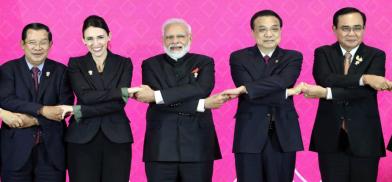Can India be a silent bystander as RCEP shapes future of Asia?
On the face of it, exiting RCEP definitely represents a setback to India’s economic ambitions of engaging with the Indo-Pacific, including attracting supply chains away from China, writes N Chandra Mohan for South Asia Monitor

At a time when global trade is contracting and protectionism is gaining ground, the Regional Comprehensive Economic Partnership (RCEP), a grouping that comprises 10 members of the Association of Southeast Asian Nations (ASEAN) together with China, Japan, South Korea, Australia, and New Zealand, have inked a trading pact on November 15.
This is the culmination of eight years of hard negotiations in which India was involved till November last year when it walked out at the eleventh hour citing unmet “significant outstanding issues.”
India still has the option of joining RCEP. But all bets are off that it will do so due to its ongoing tensions with China.
It's to do with China
These “significant outstanding issues” had a good deal to do with China - the most powerful economy in RCEP - well before the tense stand-off on its border began in March-April this year. Fearing a surge in Chinese imports, India unsuccessfully sought an auto-trigger mechanism to raise tariffs on products when their imports crossed a threshold.
Apprehensive that the dragon would dump its goods through other countries, India sought in vain tighter rules of origin that determine the national source of a product. Equally important are long-standing issues relating to the limited market access of Indian goods due to non-tariff barriers in China.
India’s reluctance to be a part of a Sino-centric RCEP, however, is very much in line with its decision to review existing free trade agreements with ASEAN, Japan, South Korea and other countries. The government has stated that it will not sign any more Free Trade Agreements (FTAs) that are “trade deals with China by stealth,” according to the Times of India.
This review has been necessitated by large trade deficits with these countries. For instance, India has registered a huge deficit of USD 23.82 billion with ASEAN in 2019-20. With South Korea and Japan, it is USD 10.8 billion and USD 7.9 billion respectively. India has a trade surplus with all its South Asian neighbours.
India’s biggest trade gap is with China of USD 48.65 billion in 2019-20 which is more than all its imbalances with its FTA partners combined. This begs the question as to why it is taking a relook at its major trade deals.
Scepticism about FTAs
If it can have such a massive imbalance with the dragon despite not having an FTA, surely such agreements per se are not the reason why India has not been able to gainfully exploit the opportunities of trading with ASEAN and other partners? An internal assessment of these FTAs by the government has also indicated that the utilization rate of India and its trading partners have only been “moderate” across various sectors.
India’s ambivalence regarding RCEP and FTAs, in general, is also because domestic stakeholders like India Inc. and farmers remain far from enthusiastic about them. The industry is worried stiff that China can inundate the domestic market with cheaper steel, chemicals, and electrical goods thanks to surplus capacities.
The dairy industry is apprehensive of stiff competition in milk and milk products from Australia and New Zealand. There is also opposition from affiliates of the ruling dispensation like the Swadeshi Jagran Manch and farmer group Bharatiya Kisan Sangh.
India’s trading stance thus has been defensive instead of seizing emerging opportunities.
Looking inward
India’s ardour for trade agreements has also diminished due to an inward turn in its policy regime of late. There is a protectionist regime in place on a range of manufacturing products and agricultural commodities. Recently, it has announced a production-linked incentive scheme for 13 sectors amounting to USD 20 billion in which they have tariff protection to produce more.
How can the government then lower import duties if it chooses to join RCEP? When foreign investment proposals from bordering nations like China are subject to government approval, how can RCEP be persuaded to exclude most-favoured-nation obligations for investments?
On the face of it, exiting RCEP definitely represents a setback to India’s economic ambitions of engaging with the Indo-Pacific, including attracting supply chains away from China. RCEP bids fair to be one of the largest regional trading blocs in the making, accounting for 30 percent of the world’s population and 29 percent of global GDP.
It is likely to shape the future of Asia as it will enable greater trade and investments to flow freely through this prosperous region. As RCEP brings together Japan, South Korea, and China for the first time, it can potentially add USD 200 billion annually to global GDP, according to the Financial Times.
India cannot be a silent bystander to all these bustling business possibilities. No doubt India is apprehensive of being part of a regional trade architecture dominated by the dragon.
For this reason, it must make its FTAs with ASEAN, Japan and South Korea work more to its advantage and not be constrained by worries over ballooning trade deficits with all these trading partners.
(The writer is an economics and business commentator based in New Delhi. Views expressed are personal. He can be contacted at nchandramohan@rediffmail.com)









Post a Comment